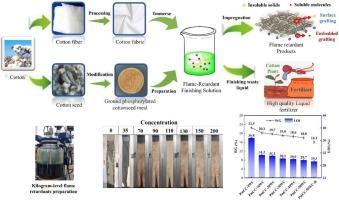机械研磨法制备棉籽粕基阻燃剂,用于棉纤维表面改性
IF 6.9
2区 材料科学
Q2 CHEMISTRY, PHYSICAL
引用次数: 0
摘要
近年来,棉纤维表面改性和阻燃的研究进展迅速。考虑到环境安全和经济可行性,生物基阻燃剂因其生态友好和可持续的特性而受到青睐。本研究成功地扩大了制备富P/ n棉籽粕基阻燃剂(PmC)的规模,PmC是一种将磷酸基团化学引入棉籽粕天然成分的功能材料。创新的机械研磨方法提炼固体生物质用于棉纤维表面。PmC通过阻燃整理工艺与棉纤维结合,在PmC与棉纤维之间形成氢键和共价键,从而实现阻燃棉纤维的持久耐洗涤性能。110 g/L PmC处理棉纤维的极限氧指数(LOI)达到38.4 %,损伤长度仅为50 mm。锥体量热测试结果表明,聚丙烯酰胺处理后棉纤维的总放热率(THR)和峰值放热率(pHRR)分别降低了38.7 %和82.9 %。TG-IR、残碳XPS、SEM-EDS综合分析进一步表明,PmC主要通过作用于棉织物的缩合相发挥阻燃作用。本文章由计算机程序翻译,如有差异,请以英文原文为准。

Scalable preparation of cottonseed meal-based flame retardants via mechanical grinding for surface modification of cotton fibers
The research progress on the surface modification and flame retardancy of cotton fibers has been rapid. Driven by considerations of environmental safety and economic feasibility, bio-based flame retardants are favored for their eco-friendly and sustainable characteristics. This study successfully scaled up the preparation of a P/N-rich cottonseed meal-based flame retardant (PmC) − a functional material in which phosphate groups are chemically introduced into the natural components of cottonseed meal. The innovative mechanical grinding method refines solid biomass for application on the surface of cotton fibers. PmC integrates with cotton fibers through a flame-retardant finishing process, forming hydrogen bonds and covalent bonds between PmC and cotton fibers, thereby achieving durable wash resistance for flame-retardant cotton fibers. The limiting oxygen index (LOI) of 110 g/L PmC treated cotton fibers reaches 38.4 %, with a damage length of only 50 mm. Cone calorimetry tests revealed that the total heat release (THR) and peak heat release rate (pHRR) of PmC-treated cotton fibers were reduced by 38.7 % and 82.9 %, respectively. Comprehensive analysis using TG-IR, residual carbon XPS, SEM-EDS further indicated that PmC primarily exerts its flame-retardant effect by acting on the condensed phase of cotton fabrics.
求助全文
通过发布文献求助,成功后即可免费获取论文全文。
去求助
来源期刊

Applied Surface Science
工程技术-材料科学:膜
CiteScore
12.50
自引率
7.50%
发文量
3393
审稿时长
67 days
期刊介绍:
Applied Surface Science covers topics contributing to a better understanding of surfaces, interfaces, nanostructures and their applications. The journal is concerned with scientific research on the atomic and molecular level of material properties determined with specific surface analytical techniques and/or computational methods, as well as the processing of such structures.
 求助内容:
求助内容: 应助结果提醒方式:
应助结果提醒方式:


